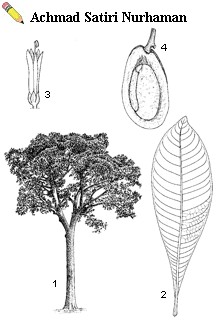Record Number
4403
PROSEA Handbook Number
5(2): Timber trees; Minor commercial timbers
Taxon
Mangifera caesia Jack
This article should be read together with the article on the genus: Mangifera (timber aspects) in the Handbook volume indicated above in this database.
This article should be read together with the article on the genus: Mangifera (timber aspects) in the Handbook volume indicated above in this database.
Protologue
Roxb., Fl. Indica ed. Carey & Wallich 2: 441 (1824).
Synonyms
Mangifera verticillata C.B. Robinson (1911).
Vernacular Names
Indonesia: binjai (South Kalimantan), palong, wani (East Kalimantan). Malaysia: binjai (general), beluno, bundo (Sabah). Philippines: baluno (Manobo), bauno (Sulu, Cebu Bisaya), balunut (Sulu). Thailand: bin-ya, lam-yai (peninsular).
Distribution
Peninsular Malaysia, Sumatra and Borneo; in cultivation and naturalized also in peninsular Thailand, western Java (rare), Bali and the Philippines (Sulu Archipelago and Mindanao); once found in Papua New Guinea.
Uses
The wood is used for light construction. The fruit is eaten raw or used as an ingredient of sambal or for making a creamy juice.
Observations
A medium-sized to fairly large tree up to 40 m tall, with bole up to 75(—115) cm in diameter, buttresses absent, bark surface superficially fissured (strips hard and glossy), grey to greyish-brown; leaves broadly lanceolate to elliptical, 6—42 cm 3—10 cm; inflorescence pseudo-terminal, densely and many-flowered; flowers 5-merous, petals 5—9 mm long, dark carmine purple with paler margins, the upper third reflexed, with one central ridge, the base connate to the stipe-like and obscurely lobed disk, one stamen fertile, free at base, staminodes 4, knob- or teeth-like; fruit subellipsoid, up to 15 cm 7 cm, yellowish or whitish-green with suffused reddish parts when ripe. Mangifera caesia closely resembles Mangifera kemanga Blume, but differs in the longer petiole and the yellowish or whitish-green and smooth fruit. Wild forms have sour fruits but there is a cultivar in Borneo and Bali with sweet, fibreless and tasty fruits. The smell of the fruit pulp is rather offensive, and the white juice of the immature fruit is very irritating to the skin and when ingested. The density of the wood is 410—570 kg/m3 at 15% moisture content.
Image
 | Mangifera caesia Jack – 1, tree habit; 2, leaf; 3, flower; 4, halved fruit. |
Selected Sources
[77]Burgess, P.F., 1966. Timbers of Sabah. Sabah Forest Records No 6. Forest Department, Sabah, Sandakan. xviii + 501 pp.
[104]Corner, E.J.H., 1988. Wayside trees of Malaya. 3rd edition. 2 volumes. The Malayan Nature Society, Kuala Lumpur. 774 pp.
[125]de Guzman, E., Umali, R.M. & Sotalbo, E.D., 1986. Guide to the Philippine flora and fauna. Vol. 3: Dipterocarps, non-dipterocarps. Natural Resources Management Centre, Ministry of Natural Resources & University of the Philippines, Quezon City and Los Baños. xx + 414 pp.
[162]Flora Malesiana (various editors), 1950–. Kluwer Academic Publishers, Dordrecht, Boston, London.
[328]Kostermans, A.J.G.H. & Bompard, J.-M., 1993. The mangoes. Their botany, nomenclature, horticulture and utilization. International Board for Plant Genetic Resources and Linnean Society of London. Academic Press, London. 233 pp.
[463]Ng, F.S.P., 1991. Manual of forest fruits, seeds and seedlings. Vol. 1. Malayan Forest Record No 34. Forest Research Institute Malaysia, Kepong. 400 pp.
[465]Ng, F.S.P. & Mat Asri Ngah Sanah, 1991. Germination and seedling records. Research Pamphlet No 108. Forest Research Institute Malaysia, Kepong. 191 pp.
[673]Verheij, E.W.M. & Coronel, R.E. (Editors), 1991. Plant resources of South-East Asia No 2. Edible fruits and nuts. Pudoc, Wageningen. 446 pp.
[705]Whitmore, T.C. & Ng, F.S.P. (Editors), 1972–1989. Tree flora of Malaya. A manual for foresters. 2nd edition. 4 volumes. Malayan Forest Records No 26. Longman Malaysia SDN. Berhad, Kuala Lumpur & Petaling Jaya.
[104]Corner, E.J.H., 1988. Wayside trees of Malaya. 3rd edition. 2 volumes. The Malayan Nature Society, Kuala Lumpur. 774 pp.
[125]de Guzman, E., Umali, R.M. & Sotalbo, E.D., 1986. Guide to the Philippine flora and fauna. Vol. 3: Dipterocarps, non-dipterocarps. Natural Resources Management Centre, Ministry of Natural Resources & University of the Philippines, Quezon City and Los Baños. xx + 414 pp.
[162]Flora Malesiana (various editors), 1950–. Kluwer Academic Publishers, Dordrecht, Boston, London.
[328]Kostermans, A.J.G.H. & Bompard, J.-M., 1993. The mangoes. Their botany, nomenclature, horticulture and utilization. International Board for Plant Genetic Resources and Linnean Society of London. Academic Press, London. 233 pp.
[463]Ng, F.S.P., 1991. Manual of forest fruits, seeds and seedlings. Vol. 1. Malayan Forest Record No 34. Forest Research Institute Malaysia, Kepong. 400 pp.
[465]Ng, F.S.P. & Mat Asri Ngah Sanah, 1991. Germination and seedling records. Research Pamphlet No 108. Forest Research Institute Malaysia, Kepong. 191 pp.
[673]Verheij, E.W.M. & Coronel, R.E. (Editors), 1991. Plant resources of South-East Asia No 2. Edible fruits and nuts. Pudoc, Wageningen. 446 pp.
[705]Whitmore, T.C. & Ng, F.S.P. (Editors), 1972–1989. Tree flora of Malaya. A manual for foresters. 2nd edition. 4 volumes. Malayan Forest Records No 26. Longman Malaysia SDN. Berhad, Kuala Lumpur & Petaling Jaya.
Author(s)
R.H.M.J. Lemmens
Correct Citation of this Article
Lemmens, R.H.M.J., 1995. Mangifera caesia Jack. In: Lemmens, R.H.M.J., Soerianegara, I. and Wong, W.C. (Editors): Plant Resources of South-East Asia No 5(2): Timber trees; Minor commercial timbers. PROSEA Foundation, Bogor, Indonesia. Database record: prota4u.org/prosea

All texts are licensed under a Creative Commons Attribution-Noncommercial-Share Alike 3.0 Netherlands License
This license does not include the illustrations (Maps,drawings,pictures); these remain all under copyright.